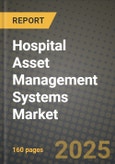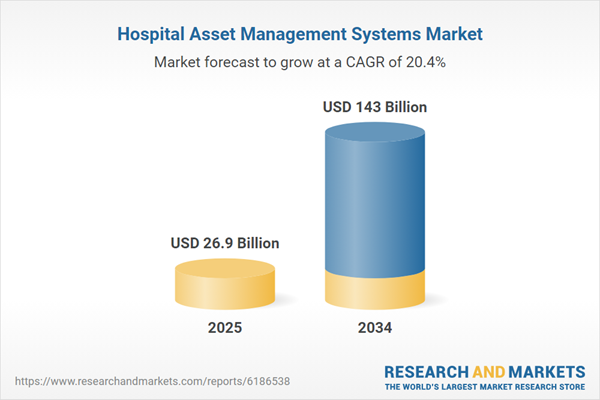The Hospital Asset Management Systems market has become a crucial enabler of operational efficiency and cost optimization in modern healthcare environments. These systems use advanced technologies such as RFID, IoT, barcoding, and real-time location systems (RTLS) to track and manage a wide array of assets including medical equipment, pharmaceuticals, and staff. As hospitals face increasing pressure to improve patient outcomes while reducing waste and operational costs, the need for reliable and scalable asset management solutions has intensified. Hospital administrators are leveraging these systems to minimize equipment loss, prevent downtime, ensure timely maintenance, and enhance inventory control. The increasing digitization of healthcare infrastructure and the rise in patient admissions across both developed and emerging economies are further accelerating the demand for automated asset tracking. As hospitals continue to evolve into data-driven organizations, asset management systems are becoming foundational tools to streamline workflows and elevate service delivery standards.
The Hospital Asset Management Systems market witnessed notable advancements and expanded implementation across various regions, especially in North America, Europe, and parts of Asia-Pacific. RFID-based systems gained wider traction due to their reliability and declining cost of deployment. Hospitals increasingly integrated asset management platforms with electronic health records (EHRs) and hospital information systems (HIS) to achieve greater visibility and synchronization of resources. The year also saw the adoption of AI-powered analytics for predictive maintenance and asset utilization forecasting, enabling healthcare facilities to optimize their capital expenditures. Leading vendors introduced cloud-based platforms offering real-time dashboards, mobile accessibility, and enhanced cybersecurity features. Moreover, mid-sized hospitals and specialty clinics began embracing these systems to address resource constraints and improve patient flow management. Investments by public and private healthcare institutions were bolstered by supportive regulations and funding initiatives promoting healthcare IT adoption.
The Hospital Asset Management Systems market is expected to evolve rapidly, fueled by the growing emphasis on automation, interoperability, and patient safety. Emerging technologies such as edge computing, blockchain, and 5G connectivity are anticipated to enhance the performance and scalability of these systems. Hospitals will increasingly adopt fully integrated, AI-driven platforms capable of real-time decision-making and adaptive resource allocation. The shift toward smart hospitals and connected health ecosystems will drive demand for interoperable solutions that seamlessly link asset tracking with patient monitoring, workforce management, and clinical operations. Additionally, with rising concerns about cybersecurity and data integrity, providers are expected to invest in more secure and compliant platforms. The market will also benefit from rising global healthcare investments, expansion of medical infrastructure in developing regions, and the growing trend of value-based care that prioritizes efficiency and measurable outcomes over volume-driven practices.
Key Insights: Hospital Asset Management Systems Market
- Hospitals are increasingly adopting AI-enabled asset management systems to enhance resource allocation and enable predictive maintenance for critical medical equipment.
- Integration of hospital asset tracking with patient flow and EHR systems is improving operational visibility and decision-making across clinical workflows.
- Cloud-based asset management platforms are gaining popularity for their scalability, real-time monitoring capabilities, and reduced IT overhead.
- Increased focus on sustainability is driving the adoption of asset lifecycle management tools to reduce waste and optimize equipment utilization.
- Expansion of hospital infrastructure in emerging markets is creating new opportunities for localized, affordable asset management solutions.
- Rising demand for efficient hospital operations and reduced operational costs is driving adoption of advanced asset tracking systems.
- Growing investments in healthcare IT infrastructure are enabling hospitals to modernize and digitize their asset management practices.
- Government regulations and incentives supporting healthcare digitization are encouraging hospitals to implement asset management solutions.
- Increasing instances of equipment loss and theft are compelling healthcare providers to invest in real-time location tracking technologies.
- High implementation costs, including hardware, software, training, and integration, pose a significant barrier to adoption for smaller healthcare facilities.
Hospital Asset Management Systems Market Segmentation
By Product Type
- Radio-Frequency Identification (RFID)
- Real-Time Location Systems (RTLS)
- Ultrasound and Infrared Tags
By Application
- Patient Management
- Equipment Tracking and Management
- Temperature and Humidity Control
- Infection Control and Hygiene Compliance
- Staff Management
- Pharmaceutical Asset Management
- Other Applications
By End-Use
- Hospitals
- Laboratories
- Other End Users
Key Companies Analysed
- McKesson Corporation
- International Business Machines Corporation
- Honeywell International Inc.
- Siemens Healthineers
- GE Healthcare Technologies Inc.
- Zebra Technologies Corporation
- Cerner Corporation
- Trimble Inc.
- Philips Healthcare
- Hill-Rom Holdings Inc.
- Midmark Corporation
- Stanley Healthcare
- Ascom Holding AG
- Accruent LLC.
- Identiv Inc.
- RF Technologies Inc.
- CenTrak Inc.
- Fiix
- Ekahau Inc.
- Jadak Technologies Inc.
- SmartPoint Technologies Pvt Ltd.
- Asset Panda
- Securitas Healthcare LLC.
- Halt Medical Inc.
- AiRISTA Flow Inc.
- Versus Technology Inc.
- Asset infinity
- InnoMaint
- Ezofficeinventory
- Sonitor Technologies AS.
Hospital Asset Management Systems Market Analytics
The report employs rigorous tools, including Porter’s Five Forces, value chain mapping, and scenario-based modeling, to assess supply-demand dynamics. Cross-sector influences from parent, derived, and substitute markets are evaluated to identify risks and opportunities. Trade and pricing analytics provide an up-to-date view of international flows, including leading exporters, importers, and regional price trends.Macroeconomic indicators, policy frameworks such as carbon pricing and energy security strategies, and evolving consumer behavior are considered in forecasting scenarios. Recent deal flows, partnerships, and technology innovations are incorporated to assess their impact on future market performance.
Hospital Asset Management Systems Market Competitive Intelligence
The competitive landscape is mapped through proprietary frameworks, profiling leading companies with details on business models, product portfolios, financial performance, and strategic initiatives. Key developments such as mergers & acquisitions, technology collaborations, investment inflows, and regional expansions are analyzed for their competitive impact. The report also identifies emerging players and innovative startups contributing to market disruption.Regional insights highlight the most promising investment destinations, regulatory landscapes, and evolving partnerships across energy and industrial corridors.
Countries Covered
- North America - Hospital Asset Management Systems market data and outlook to 2034
- United States
- Canada
- Mexico
- Europe - Hospital Asset Management Systems market data and outlook to 2034
- Germany
- United Kingdom
- France
- Italy
- Spain
- BeNeLux
- Russia
- Sweden
- Asia-Pacific - Hospital Asset Management Systems market data and outlook to 2034
- China
- Japan
- India
- South Korea
- Australia
- Indonesia
- Malaysia
- Vietnam
- Middle East and Africa - Hospital Asset Management Systems market data and outlook to 2034
- Saudi Arabia
- South Africa
- Iran
- UAE
- Egypt
- South and Central America - Hospital Asset Management Systems market data and outlook to 2034
- Brazil
- Argentina
- Chile
- Peru
Research Methodology
This study combines primary inputs from industry experts across the Hospital Asset Management Systems value chain with secondary data from associations, government publications, trade databases, and company disclosures. Proprietary modeling techniques, including data triangulation, statistical correlation, and scenario planning, are applied to deliver reliable market sizing and forecasting.Key Questions Addressed
- What is the current and forecast market size of the Hospital Asset Management Systems industry at global, regional, and country levels?
- Which types, applications, and technologies present the highest growth potential?
- How are supply chains adapting to geopolitical and economic shocks?
- What role do policy frameworks, trade flows, and sustainability targets play in shaping demand?
- Who are the leading players, and how are their strategies evolving in the face of global uncertainty?
- Which regional “hotspots” and customer segments will outpace the market, and what go-to-market and partnership models best support entry and expansion?
- Where are the most investable opportunities - across technology roadmaps, sustainability-linked innovation, and M&A - and what is the best segment to invest over the next 3-5 years?
Your Key Takeaways from the Hospital Asset Management Systems Market Report
- Global Hospital Asset Management Systems market size and growth projections (CAGR), 2024-2034
- Impact of Russia-Ukraine, Israel-Palestine, and Hamas conflicts on Hospital Asset Management Systems trade, costs, and supply chains
- Hospital Asset Management Systems market size, share, and outlook across 5 regions and 27 countries, 2023-2034
- Hospital Asset Management Systems market size, CAGR, and market share of key products, applications, and end-user verticals, 2023-2034
- Short- and long-term Hospital Asset Management Systems market trends, drivers, restraints, and opportunities
- Porter’s Five Forces analysis, technological developments, and Hospital Asset Management Systems supply chain analysis
- Hospital Asset Management Systems trade analysis, Hospital Asset Management Systems market price analysis, and Hospital Asset Management Systems supply/demand dynamics
- Profiles of 5 leading companies - overview, key strategies, financials, and products
- Latest Hospital Asset Management Systems market news and developments
Additional Support
With the purchase of this report, you will receive:- An updated PDF report and an MS Excel data workbook containing all market tables and figures for easy analysis.
- 7-day post-sale analyst support for clarifications and in-scope supplementary data, ensuring the deliverable aligns precisely with your requirements.
- Complimentary report update to incorporate the latest available data and the impact of recent market developments.
This product will be delivered within 1-3 business days.
Table of Contents
Companies Mentioned
- McKesson Corporation
- International Business Machines Corporation
- Honeywell International Inc.
- Siemens Healthineers
- GE Healthcare Technologies Inc.
- Zebra Technologies Corporation
- Cerner Corporation
- Trimble Inc.
- Philips Healthcare
- Hill-Rom Holdings Inc.
- Midmark Corporation
- Stanley Healthcare
- Ascom Holding AG
- Accruent LLC.
- Identiv Inc.
- RF Technologies Inc.
- CenTrak Inc.
- Fiix
- Ekahau Inc.
- Jadak Technologies Inc.
- SmartPoint Technologies Pvt Ltd.
- Asset Panda
- Securitas Healthcare LLC.
- Halt Medical Inc.
- AiRISTA Flow Inc.
- Versus Technology Inc.
- Asset infinity
- InnoMaint
- Ezofficeinventory
- Sonitor Technologies AS.
Table Information
| Report Attribute | Details |
|---|---|
| No. of Pages | 160 |
| Published | October 2025 |
| Forecast Period | 2025 - 2034 |
| Estimated Market Value ( USD | $ 26.9 Billion |
| Forecasted Market Value ( USD | $ 143 Billion |
| Compound Annual Growth Rate | 20.4% |
| Regions Covered | Global |
| No. of Companies Mentioned | 30 |







